The following are the fabulous winners and finalists for the Spring 2025 classic #USvsHate contest! We asked youth, educator, and community voters: Which do you most want amplified in schools and publicly?
In #USvsHate, we define “hate” as any time people denigrate, disrespect or harm an individual or group as if their identity makes them an inferior or less valuable type of person. By amplifying “anti-hate” youth voices in schools and publicly, we seek to empower students to build schools and a society where all belong, feel included, and get supported.
Winners
Anisha, Grade 11, Florida
Anisha writes: “Overall, my intention with this piece was to challenge the thin and Caucasian nature of the beauty standard for women in current society and celebrate those who do not fit that standard, promoting self-love of one’s body. It has always irked me greatly that fatness is seen as inherently disgusting and something to be ashamed of, and to counter that notion, I tried to equate the goddess Venus — particularly drawing specific inspiration from the statue Venus of the Nile, which symbolizes the epitome of grace and attractiveness and desirability — to a woman who does not fit the slim, white idea; furthermore, I also thought about how Venus in some myths is described to change their appearance to what the viewer finds the most beautiful or admirable, and for that ideal to be inclusive of those with a diverse range of bodies should not be such a far-fetched and “radical” idea. My fat and confident Venus stands tall, breaking out of the marble casing that her “original” version is trapped in — she is raw and real and realistic and despite her missing marble arm, she still smiles and reaches for the Sun’s rays in all her glory while donning her blue first-prize sash. Behind her, a stained glass window depicts scenes of plus size women taking pride in their bodies (ringed by the sea, referencing Venus’ birth from seafoam, a few flowers symbolizing Venus such as the anemone and myrtle, and the nemophilia flower, which symbolizes triumph).”

Anonymous, Grade 9, California
Anonymous writes: “If I were to go back in time and speak to my middle-school self, I’d tell them that they’re beautiful. As an insecure nonbinary teen, societal standards for what girls or boys should be weighed heavily on me. I thought that my face was too round and feminine, my thighs too big to ever be androgynous enough. Not only was I not “nonbinary enough”, I wasn’t even pretty enough. When I gathered the courage to correct my friends, teachers, and parents on my pronouns, the crippling weight of self-doubt lightened. Slowly and steadily without this weight, I was able to grow the belief that I was, indeed, beautiful. My beauty doesn’t purely stem from my femininity, but instead, all of the small things that make me an individual; the things that make me kind, smart, pretty, and yes, nonbinary. Research finds that one in every four suicides in people between ages fourteen and eighteen is committed by LGBTQIA+ youth (Newport Academy). More trans teens need to know their worth, beauty, and lovability. My intent with this piece is to show that beauty and love aren’t defined, limited, or restrained by a gender binary.”
The teacher explains: “Students were introduced to the idea of hate and oppression, and then were asked to make a creative piece that resisted/refuted hate.”
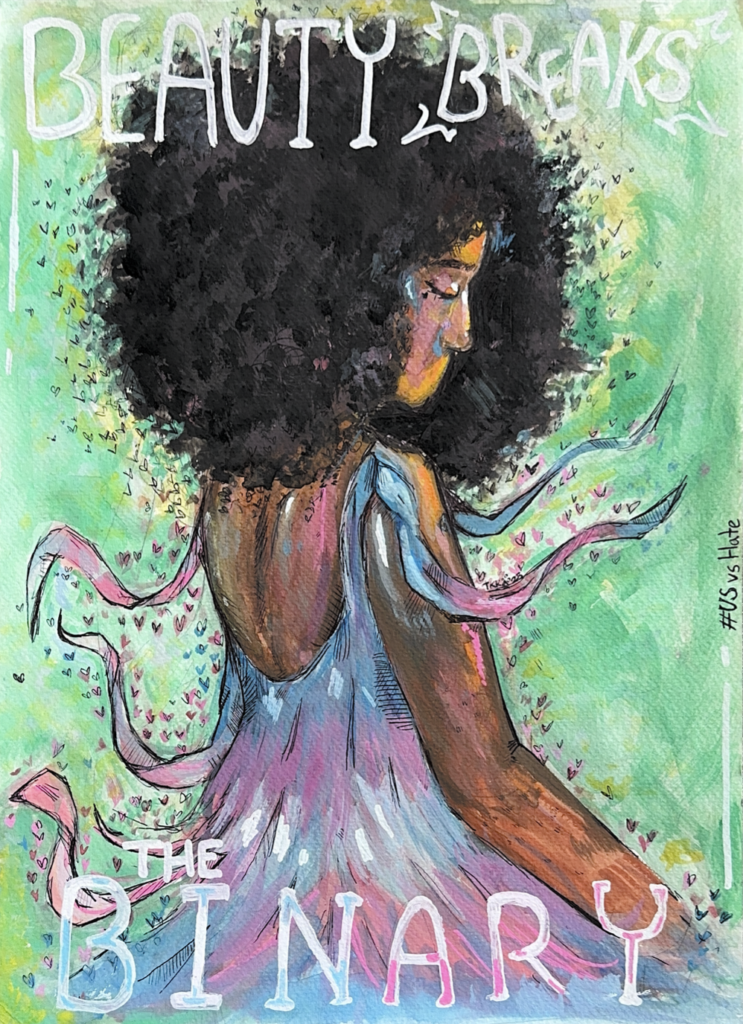
Sarah, Grade 12, California
Sarah writes: “In Japanese mythology, cranes are mythical creatures that live for one thousand years. Along with this legend, it is also believed that if a person folds one thousand origami paper cranes, then they will be granted one wish. In my artwork, the one wish I want to be granted is for unnecessary hatred of all kinds to end. I left the phrase vague on purpose though, allowing the viewer of the artwork to include their own wish into the piece as well. My wish may be different from yours, but we will always have the same idea in common: undeserved hatred needs to end. The lack of skin color in the person’s outstretched hands serves to represent that it could be any one of us who can have their wish granted. Again, the viewer is able to insert themselves into the piece and resonate with it on a personal level. With the outstretched hands and the cranes flying away, I wanted to represent how one day, the cranes will grant our wish. No matter how long it may take, the hatred affecting our lives the most will end. Thank you!”
View full (unscanned) submission here.
The teacher explains: “My US History students were asked to create an #USvsHate message after learning about stereotypes, how they can create hate in American society and how Americans throughout history to today have and continue to combat this hate.”
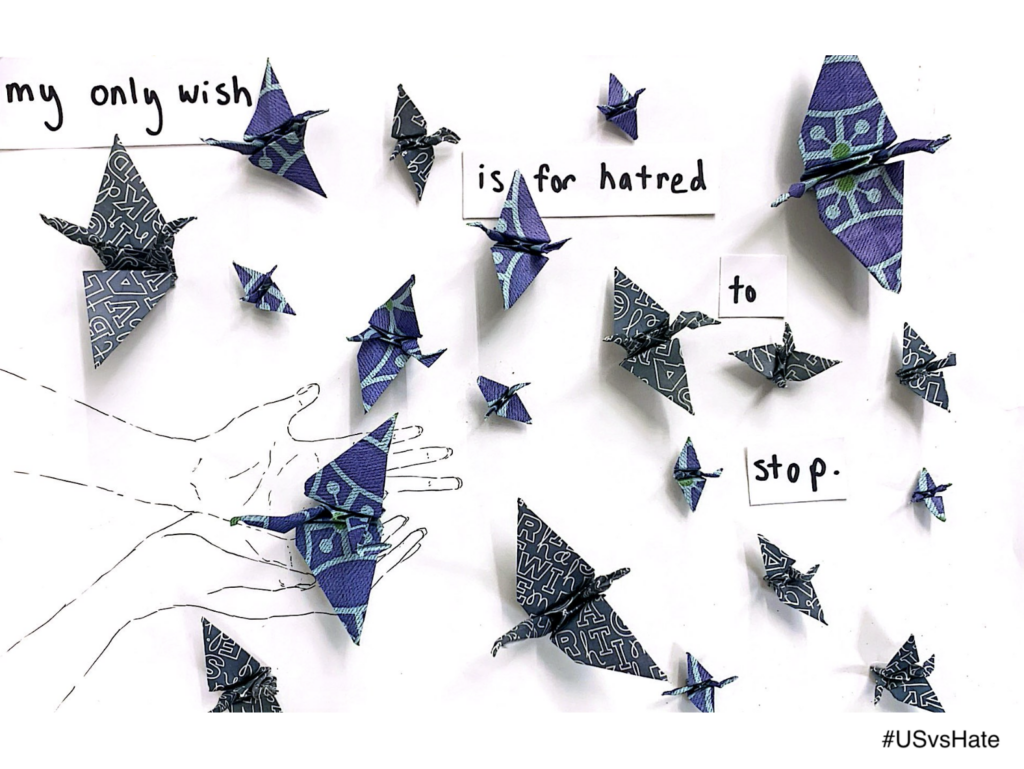
Maisy, Grade 12, California
Maisey writes: “My message is meant to convey the lack of equality for women and those who can conceive, not having as many opportunities in the workforce, in education, and being able to make their own personal decisions. We should be reminded of the fact that they were the ones who gave us a chance at having successful lives, despite being the ones facing the tallest barriers. My mom has been the biggest inspiration for this piece, and to me because I’ve watched her work in a male-dominated field, overcoming more challenges and having to prove herself more than her peers. Not because she isn’t as intelligent, or as determined, but because she is a woman.”
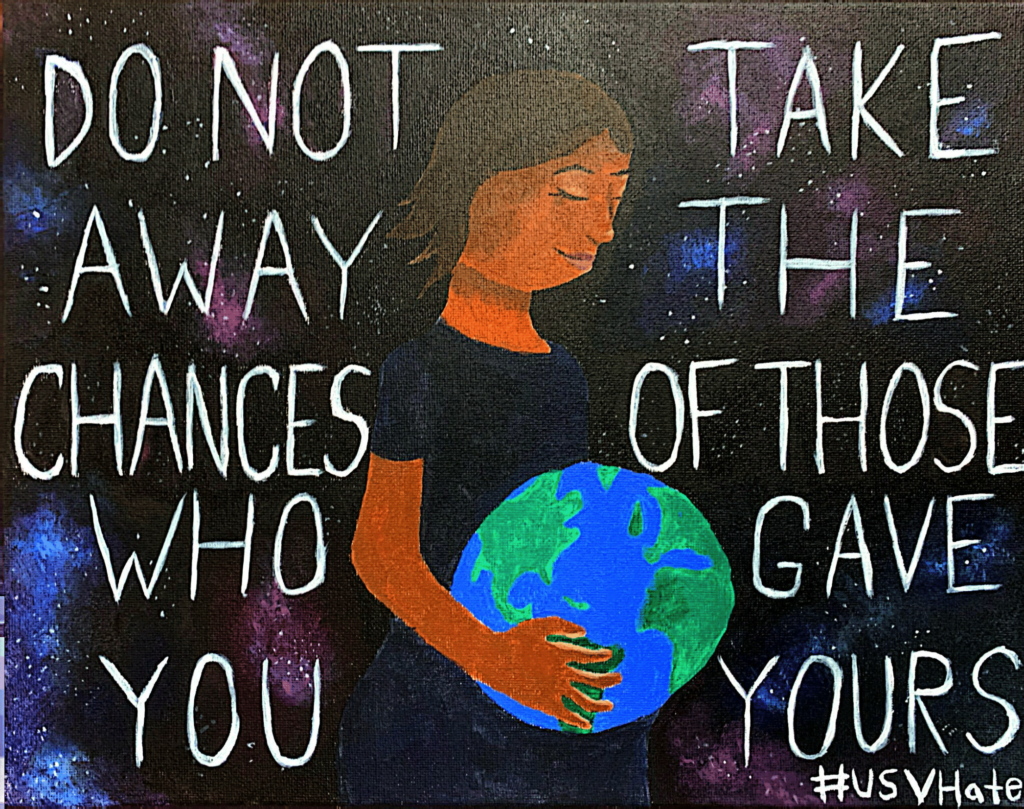
Anonymous, Grade 9, California
Anonymous writes: “My main goal in this art piece I drew was to address transphobia, which is the fear of transgender people. I wrote, “Stop transphobia,” as the main message, but the other two messages are directed towards trans people to say that they can choose who they want to be and that they are beautiful no matter what other people tell and think of them. The peacock that is flying represents freedom and its wings flap outside of the lines to show that trans people can go beyond the border of what people say they have to be. The other peacock represents the outer and inner beauty of who they are. Even though these messages apply to everyone and not just trans people, I chose to center this art piece around transphobia because I want trans people to know that they deserve the same amount of support, that they need to look past what others say to bring them down, and that there is nothing about them that they should be ashamed of.”
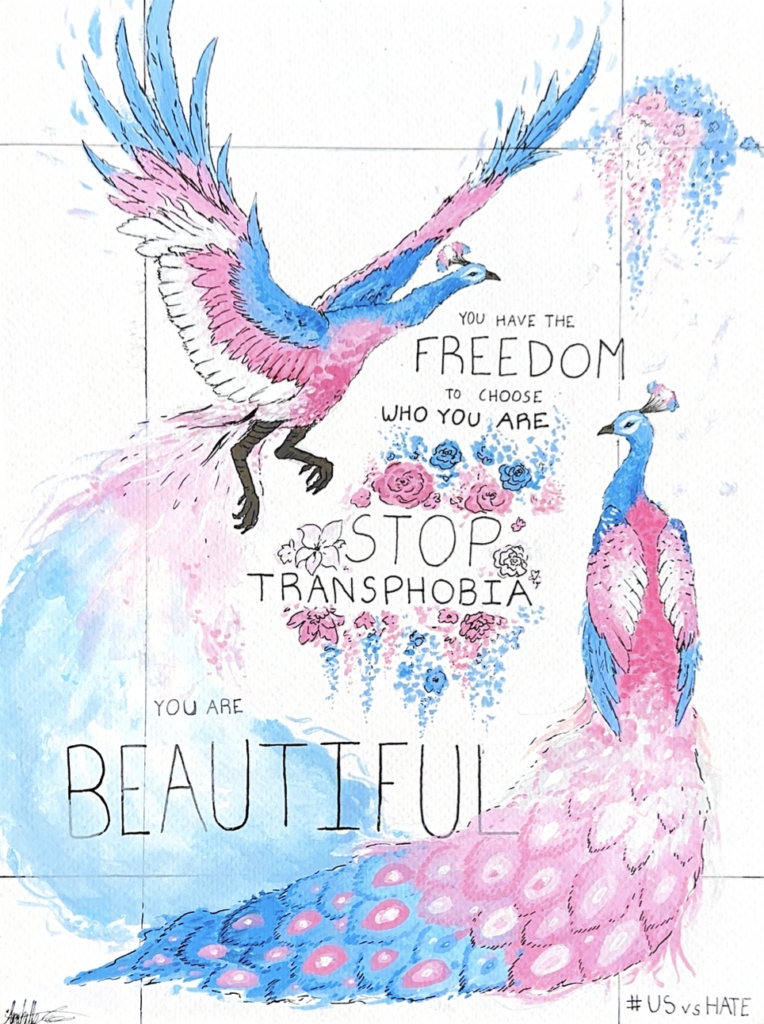
Anonymous, Grade 9, Florida
Anonymous writes: “I want you to consider something. If the words you said about someone would visually appear on their body, would you still say horrible things? Would you let them walk around with slurs and insults draped upon their shoulders like heavy chains? How would you feel when your mother had insults etched into her skin? When your little sister came home with tears in her eyes as she showed you the slur written across her leg? If the words you said would be as permanent on another’s skin as they were in their heads would you change the way you speak? I think It’s really important to spread positive messages to one another, because the words you say stick around, maybe even forever.”

Anonymous | Grade 9 | California
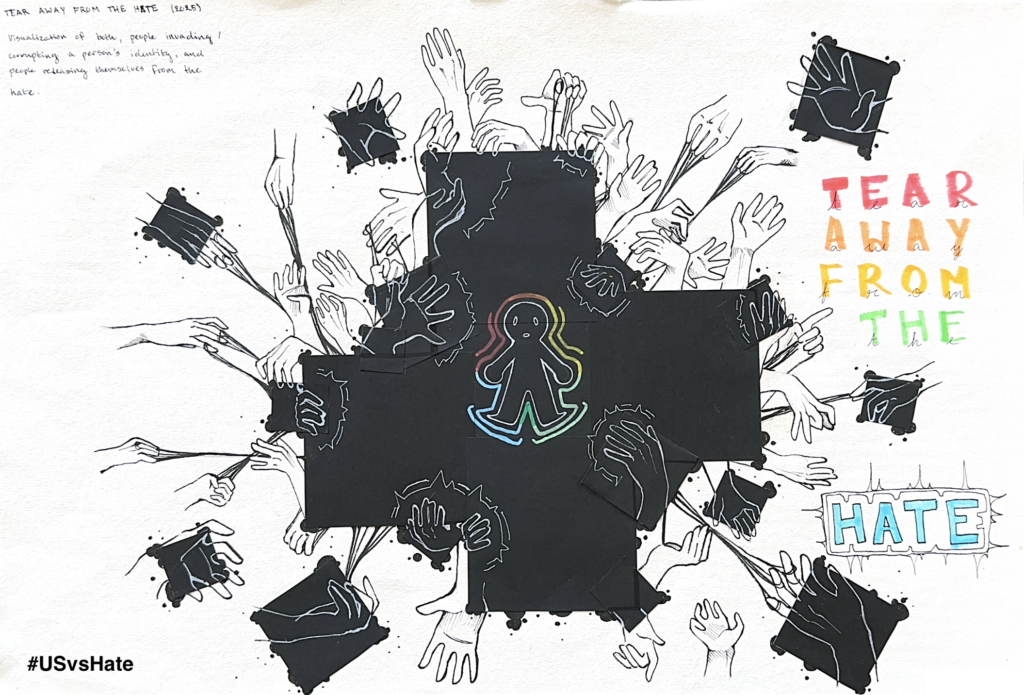
Anonymous | Grade 9 | California
Anonymous writes: “My message is that you should spread love, not hate. No matter our differences, everyone should be seen and be treated equally. I chose this message because I hope it can contribute to the #Us vs Hate project and show that hate won’t get us anywhere, but spreading love will bring us together. This message is really important because nobody should be mistreated and feel like they don’t belong, no matter our skin color or differences. Spreading love will get us somewhere.”
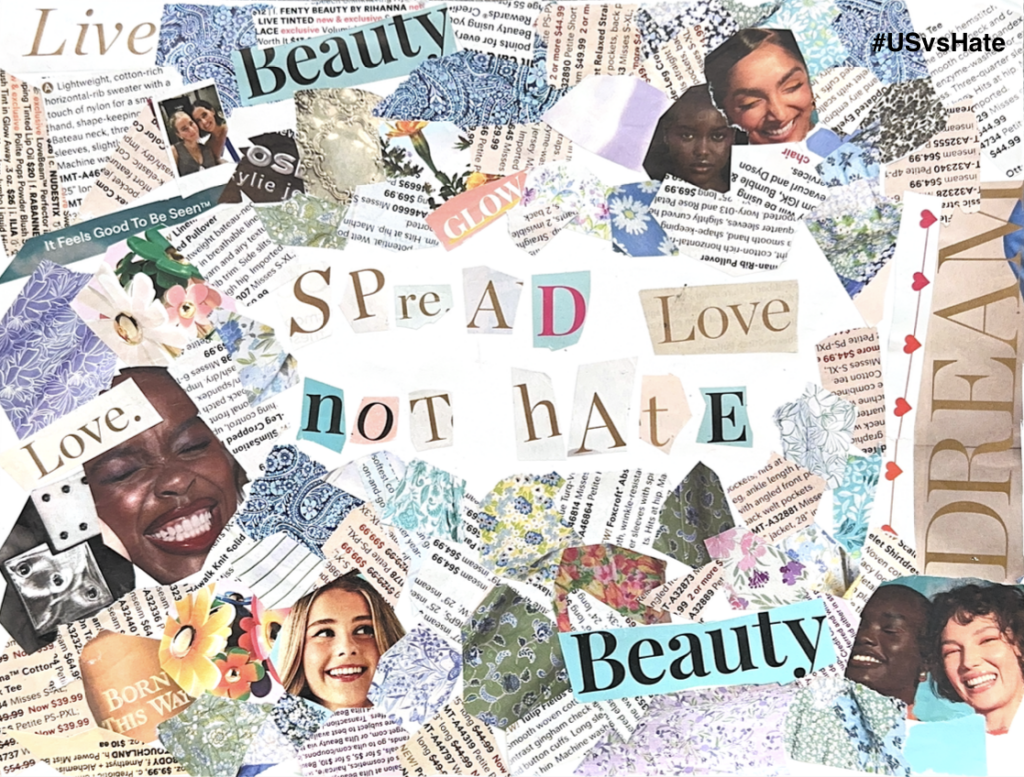
Finalists
Nikita | Grade 11 | California
Nikita shares: “When gathering my past experiences, I recalled how there was a lot of scrutiny towards Asian Americans during and after the COVID-19 pandemic. In the past, most Americans had ignored Asian American culture and identity, but there was suddenly an enormous spotlight on the country following this large-scale medical disaster. Nevertheless, I have seen how my peers have worked even harder after this incident to ensure that their voices are heard, their identity is clarified, and their love is spread throughout, replacing the role of hate in society. I, myself, have participated in many of these events and learned the importance of such diversity in not only our school setting but also the entire world.”
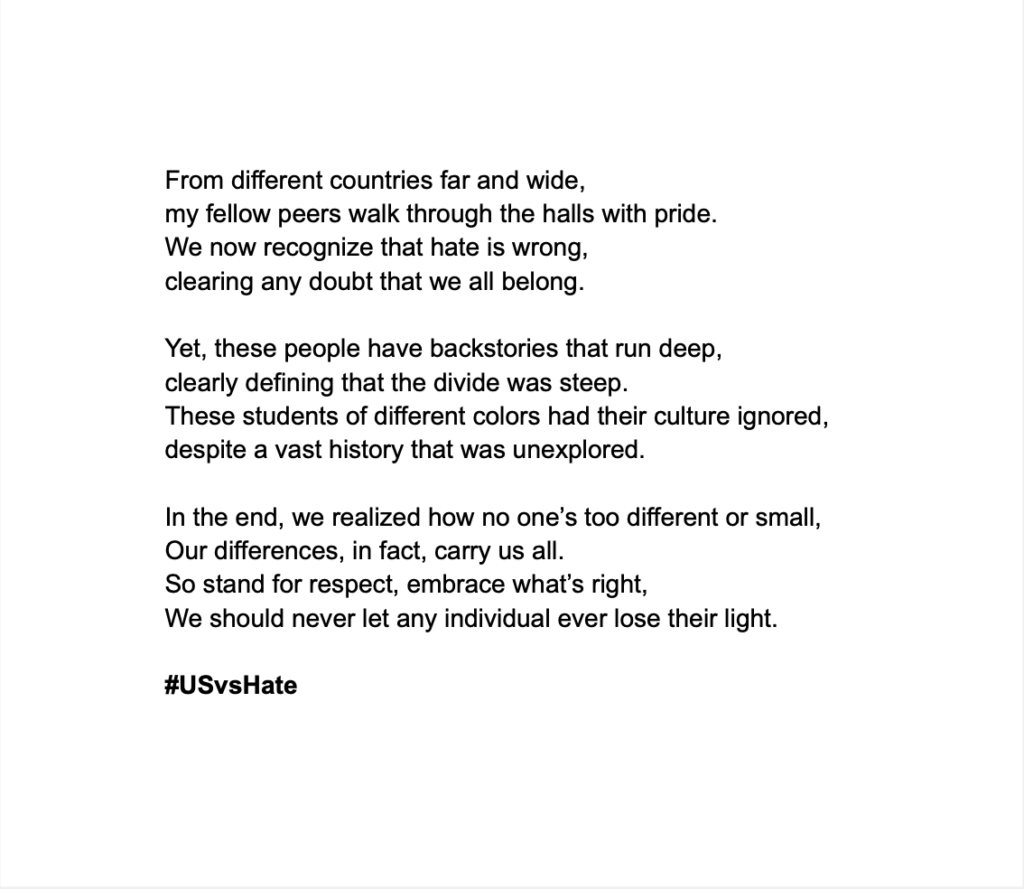
Anonymous | Grade 11 | California
Anonymous writes: “Inclusion isn’t just a choice, it’s a responsibility. We should stand up against hate and celebrate what makes each of us unique. This is the main message that I want to share with others because I have seen how harmful it is when people are shamed for who they are. My cousin came out gay, and not only did he face unfair treatment, but he has also been called slurs no one should ever hear. I’ve also experienced body shaming myself and have been called names because of my weight. Things like this make me feel like I don’t belong and that I should change who I am or how I look to fit in with others. But I want that to change. These experiences made me realize that no one should feel less than or unworthy because of who they are or how they look. At school, we should not only learn the importance of inclusion but also how to actively support each other. By understanding and appreciating our differences, we can create a community where everyone feels welcome, seen, and valued.”
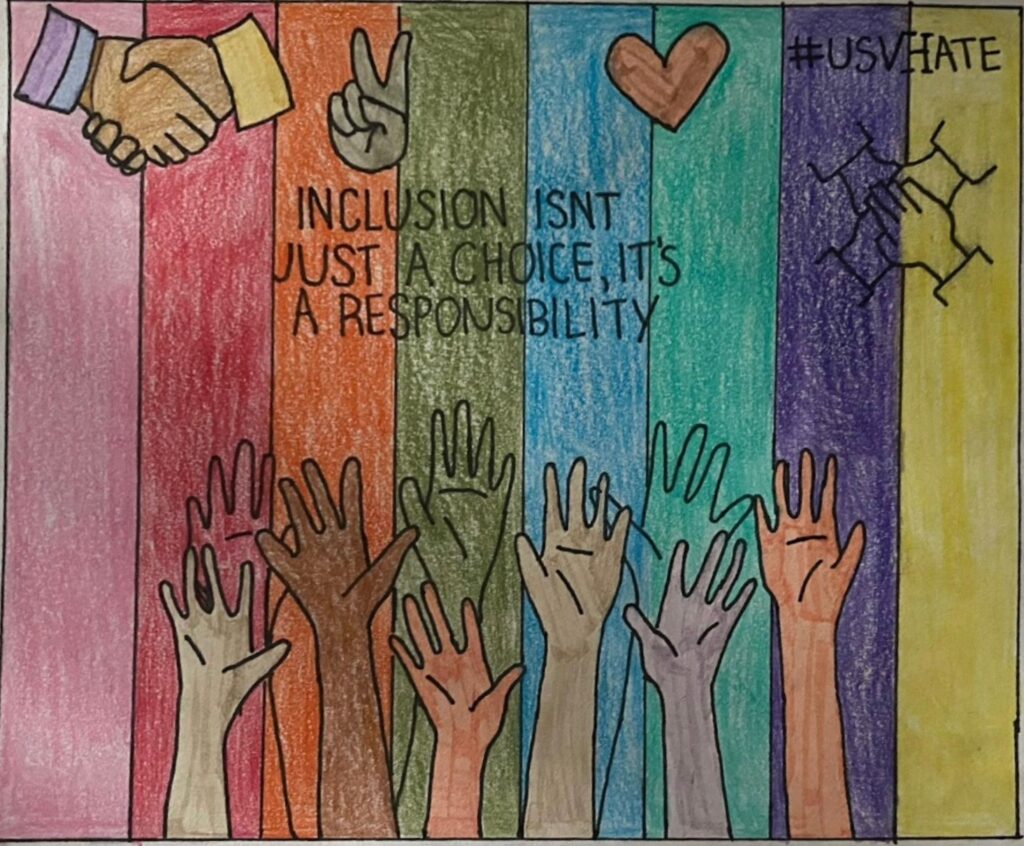
Anonymous | Grade 8 | Kentucky
Anonymous writes: “I’m telling this fictional story based on moments in my life when I have experienced racism during the COVID pandemic. I want this story to emphasize the importance of elderly minorities sharing their stories with younger generations, so we can learn from their experiences and culture.”
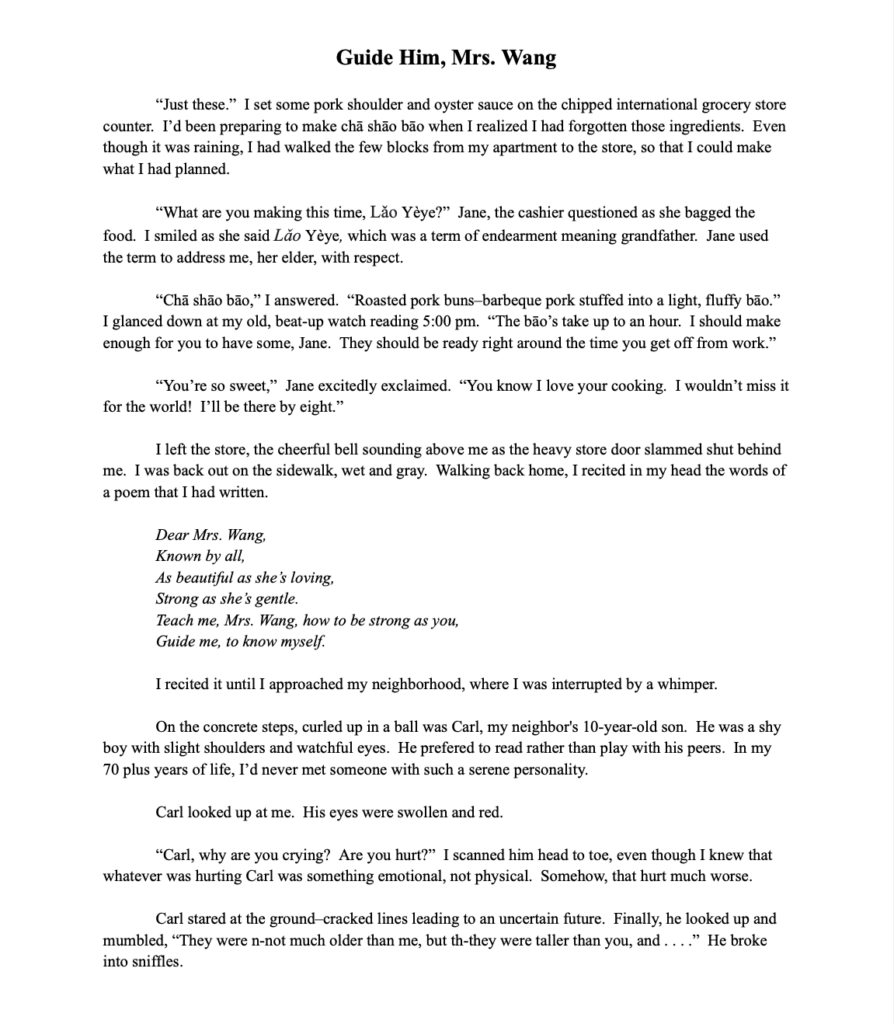
Anonymous | Grade 1 | California
The teacher writes: “Throughout the school year we have been reading books about inclusion, the celebration of differences, and the importance of speaking up for what is right. For this particular lesson we read Peter Reynolds’ book, Say Something and examined the words and actions that make a difference in the world. We also read The Noisy Paintbox, a book about the artist Kandinsky and his exploration of art and color and sound–resulting in abstract painting. Students then picked a word or phrase they believed would make the world a better place and designed a poster using oil pastels.”
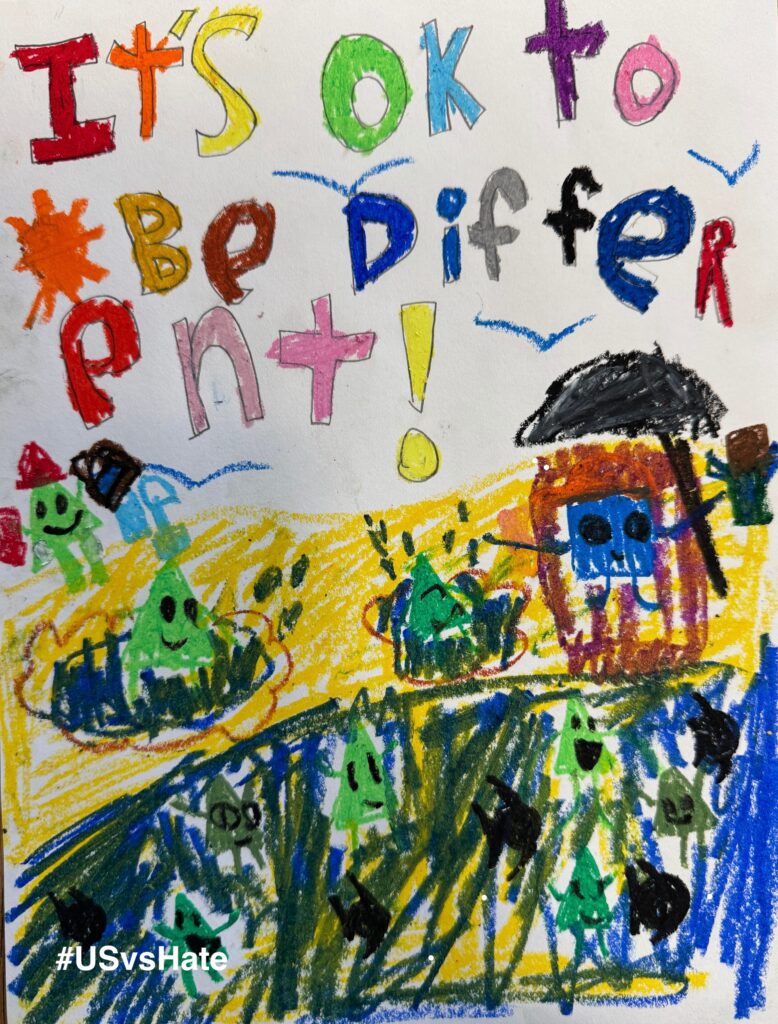
Anonymous | Grade 9 | California
Anonymous explains: “I was inspired to make this piece because of the amount of immigrants employed in labor and health care jobs and the importance they have towards our community. Much of America is built and sustained by our immigrant population. Many people underestimate the importance of our immigrant population. Whole communities, and economies rely on the hardworking and dedicated immigrant population. By making this piece I stand up to Xenophobia. Most Xenophobic people don’t understand the true importance of the immigrant population. They do all the things that the rest of America is too lazy to do. They work their butts off working the toughest 9-5 jobs in the country and all we do is pay them back with discrimination, that does not sound fair. We should show them our true gratitude and the appreciation they deserve. By coming together and standing up to the hate xenophobia causes we can voice the vital roles immigrants have in our society.”
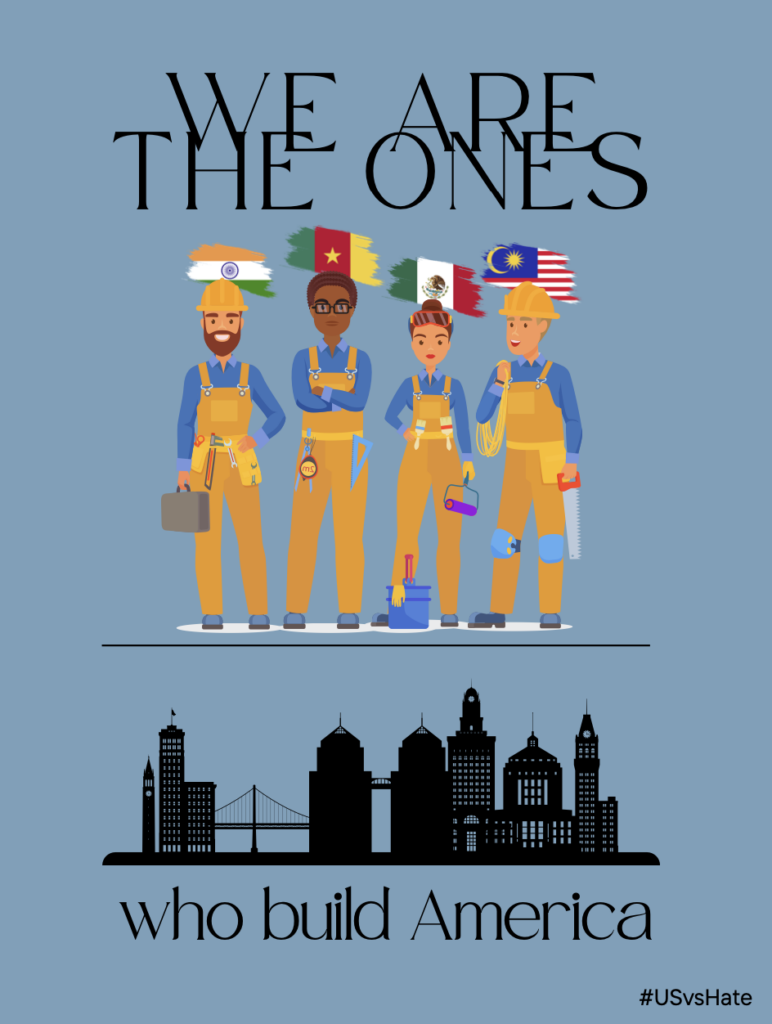
Anonymous | Grade 11 | California
Anonymous explains: “It deliberately uses as little color as possible to show how human interactions are spiritual connections, not physical ones. No matter our differences, we can all experience love and respect with new people. The hearts are colored because that’s the only part of human connection that can never change.”
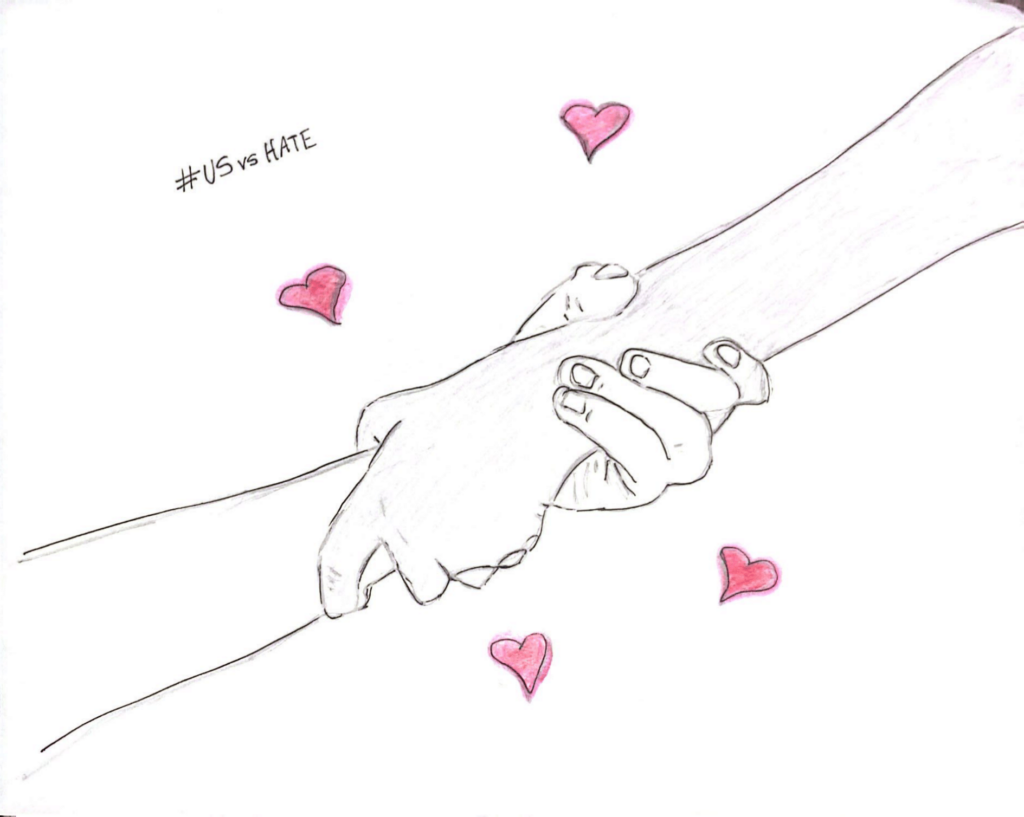
Ra | Grade 7 | Arizona
Ra explains: “I decided to make my work about inclusivity because I had to write an essay for school about the same topic. I thought it was a meaningful message, especially in a tough time for many people. The world we live in can be extremely callous and pessimistic to minority groups, and it is horrible to see the constant discrimination. I constantly feel targeted by some individuals, and no one should feel this way. Students should be able to learn about LGBTQ+ topics, various religions, and more issues without judgement, instead of pushing them to the side. The world will never improve if everything important is ignored, so we should start recognizing diversity and inclusivity to foster the future we all deserve.”
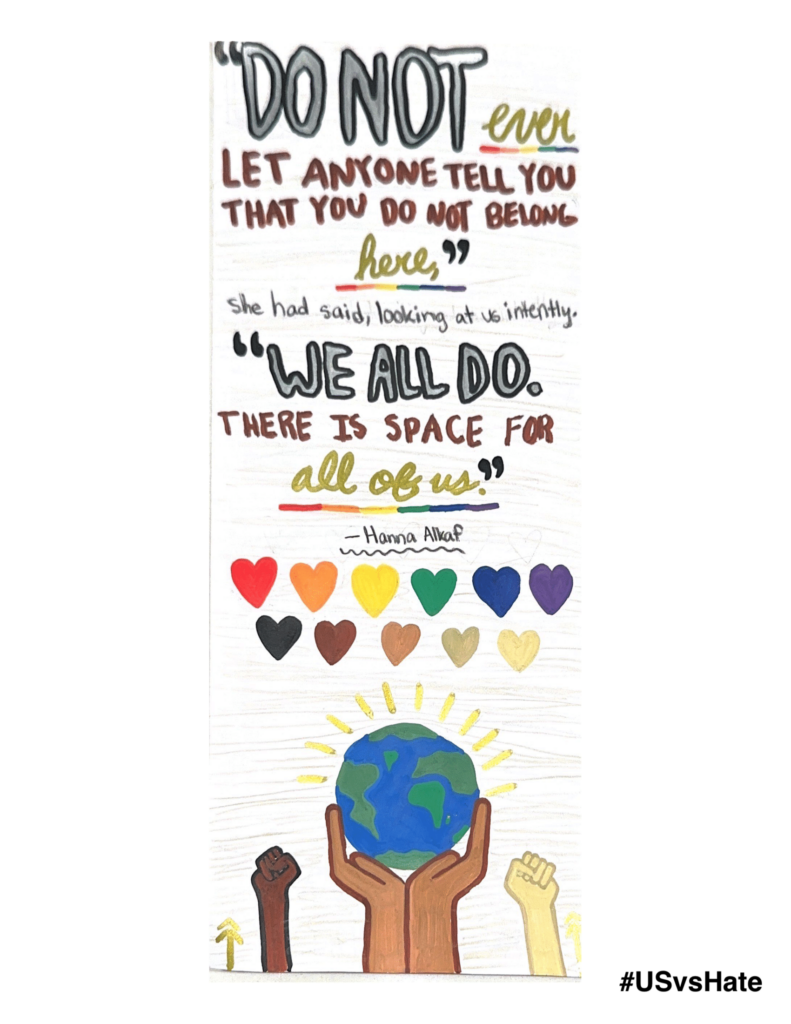
Anonymous | Grade 11 | California
Anonymous explains: “The message behind my poem is about the tendency for immigrants to be “othered” and the stereotypes that tint people’s perception of them. Often, when people view immigrants, they see them as nothing more than that: immigrants. They only note the color of their skin, religion, food, appearance, or other stereotypes. While they claim they’re open-minded and want to understand us, they don’t always strive to understand us on an individual level past our appearance. To feel more seen and valued, more students should strive to deeply listen to each other and build connections by communicating from a genuine, open perspective.”
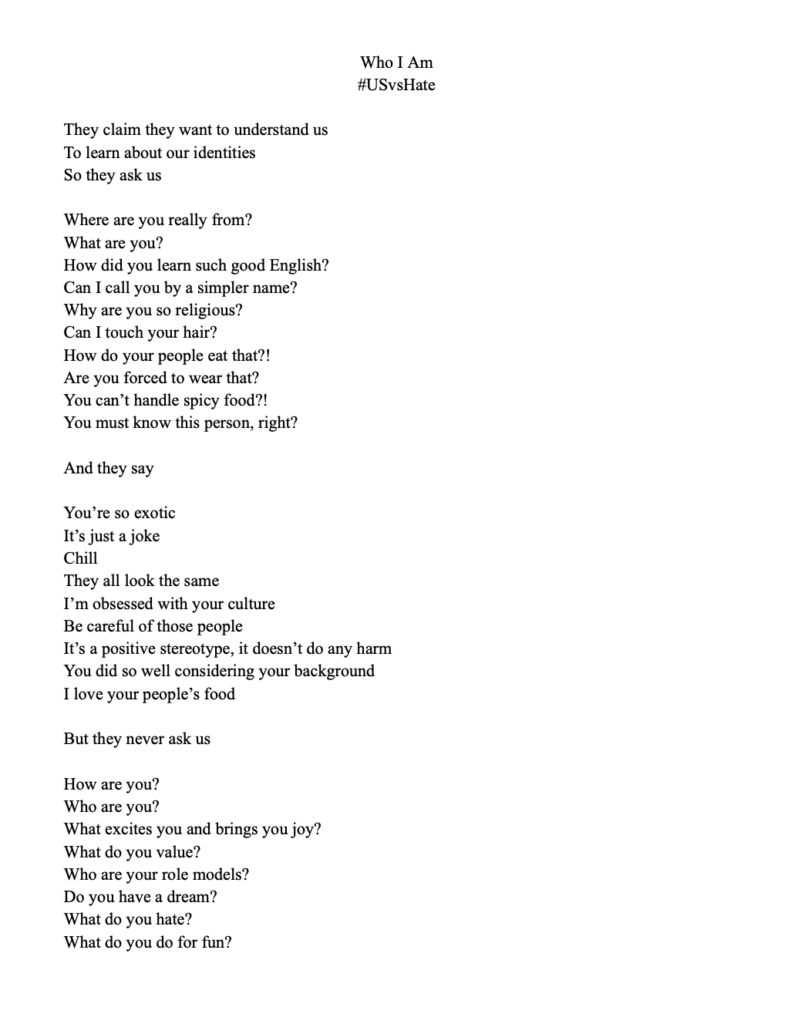
Anonymous | Grade 11 | California
Anonymous explains: “My intention behind this drawing is that everyone deserves the right to access opportunity, equality, and well-being. People with disabilities contribute to our communities, schools, and work spaces in meaningful ways. Growing up I had a class with a student that had a disability and was often underestimated, overlooked and treated differently. We need to work together to create a world where all individuals, regardless of ability, can succeed and fully participate in society. I think more students should learn about kindness, inclusion, disability rights, and accessibility in school so more students feel seen and respected.”
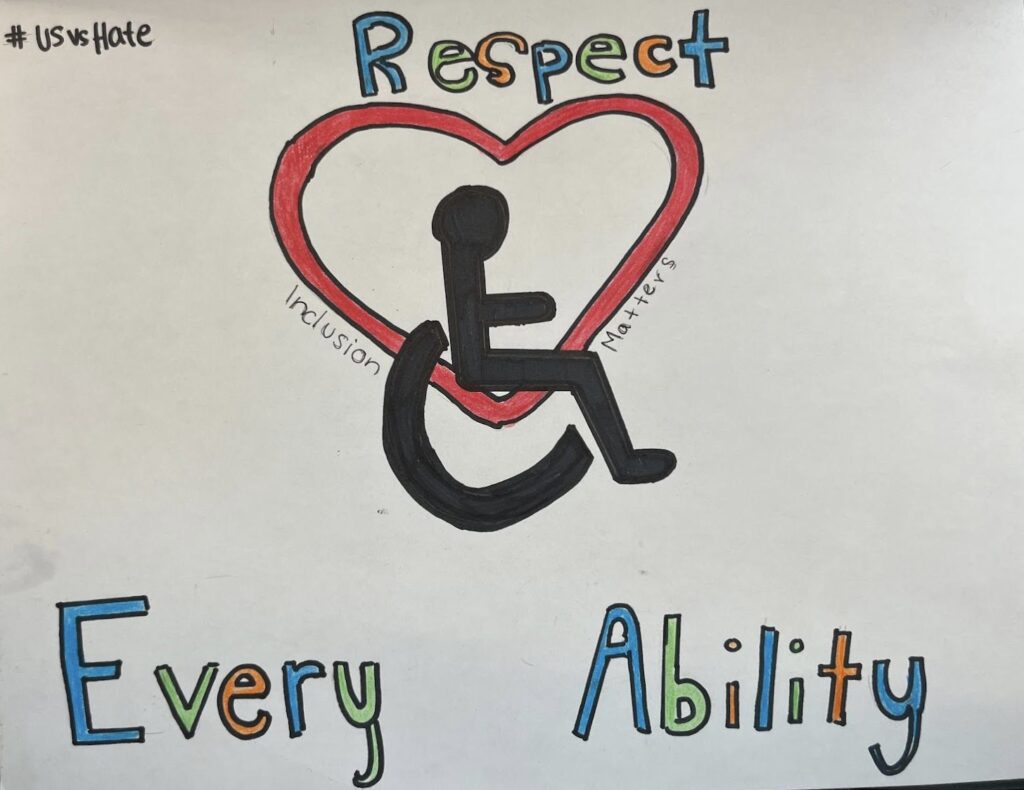
Anonymous | Grade 11 | California
Anonymous explains: “While creating this artwork, I reflected on my experiences as an Asian American and how harmful stereotypes and microaggressions impact minority groups, especially the AAPI community. Growing up and seeing the world now, I’ve witnessed people making assumptions based on race or ethnicity–whether it’s feeling foreign in America despite being American, changing the way one acts because of ethnic stereotypes, or hearing hurtful jokes. Although some of those experiences are personal to me, I am not the only one who has faced these challenges. I’ve come to realize how important it is for schools to teach about different cultures and embrace them beyond history lessons. Through this, students can see the humanity in others, rather than just what is on the outside. If we want everyone to feel valued and respected, we must create spaces where no one is reduced to just a label. #iammorethanalabel”
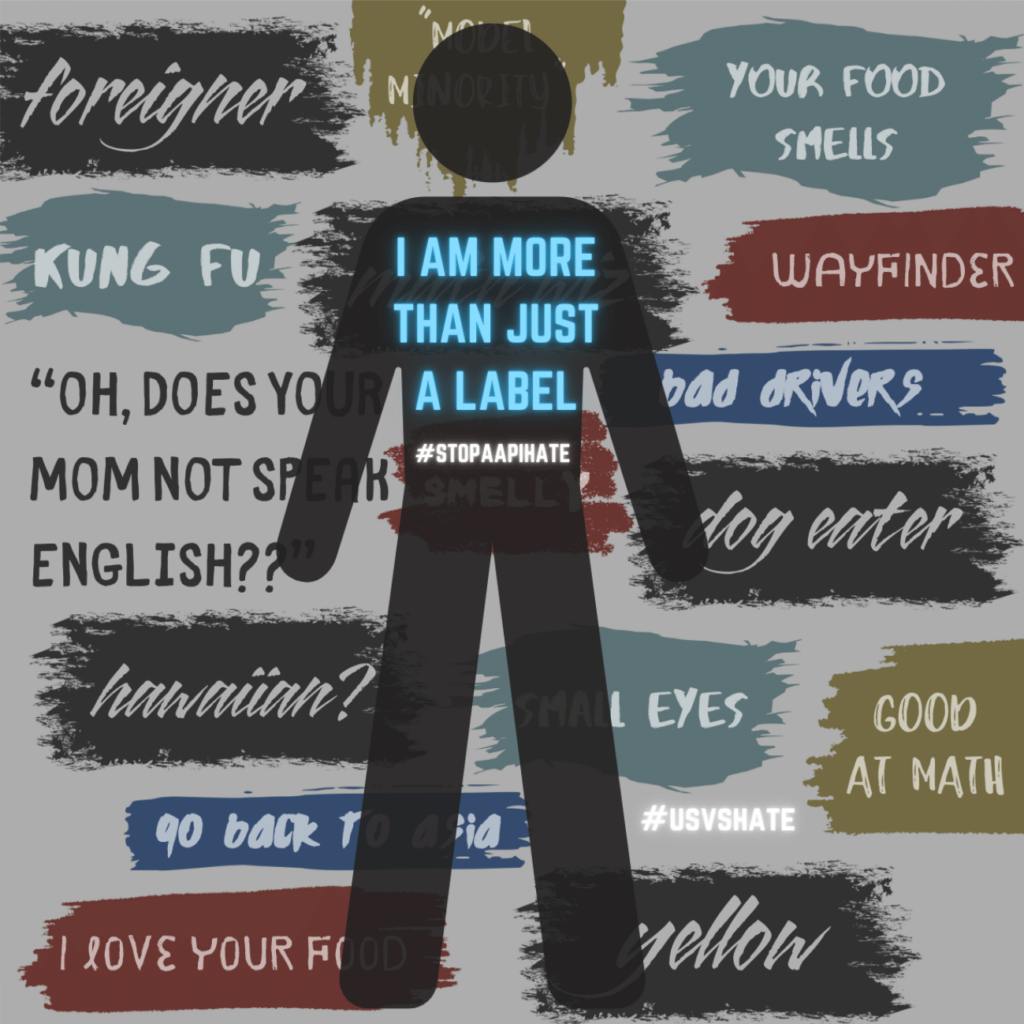
Elementary Students | Grades 3-5| Washington
The teacher explains: “Students at our Elementary took a powerful stand against hate, inspired by lessons from USvsHate! Staff kicked things off with a video challenging students to be gamechangers—and they rose to the occasion. The movement grew so strong that even the Portland Trail Blazers dancers and mascot joined in to celebrate their incredible work! Check out this video showcasing their response! #TimeOutAgainstHate #Changemakers #UsVersusHate”
Bani | Grade 6 | Florida
The parent explains: “She has read books about women’s rights and been lashed at by boys in her school because she was a girl, and she thinks that it isn’t right for you to be judged based on your gender, or the way you look. She thinks women should be free to do whatever they want, no matter what anyone says to them.”
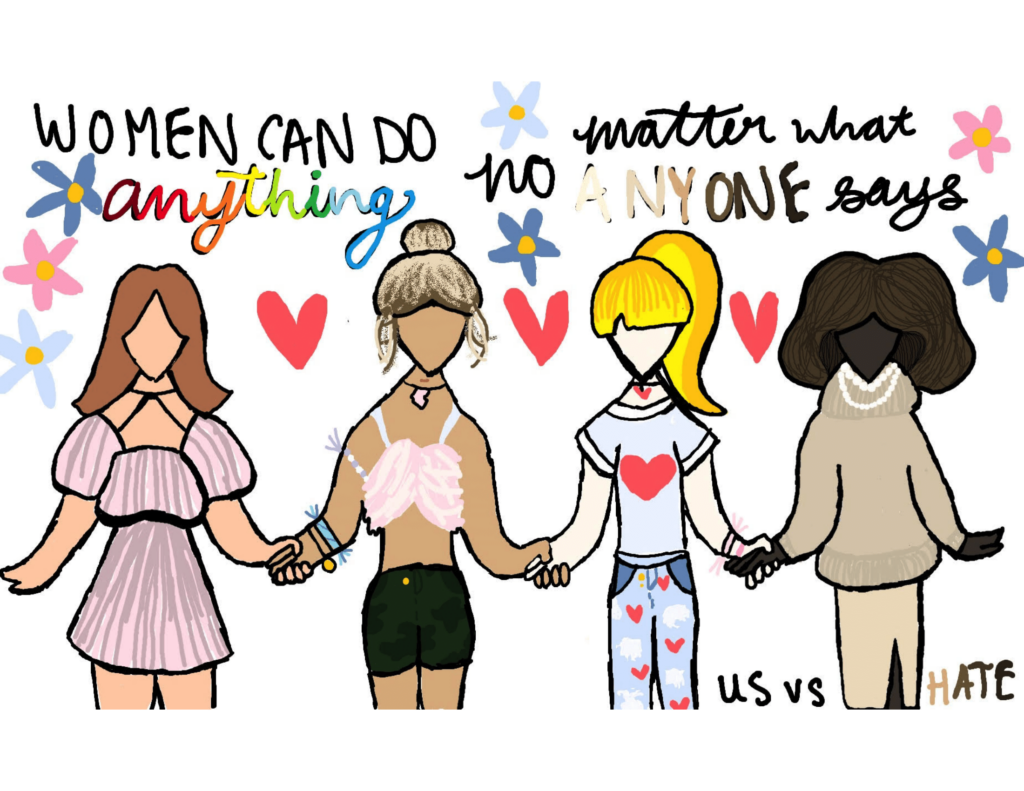
Anonymous| Grades 11| California
Anonymous explains: “With this piece, I hope to show people an example of the subtle things that make women feel “less than” in sports, and also in life. Similar to the protagonist in the animation, I am a competitive cyclist, and have had similar interactions throughout my mountain biking career. The cycling world (like many other sports) is very male-dominated, and although men might have the best of intentions, stereotypes and assumptions about women unfortunately do seep through the cracks. I think it’s important to learn that we all need to step out of our own heads, be mindful of others’ feelings, and continuously try to improve ourselves so that every person feels included, respected, and valued.”